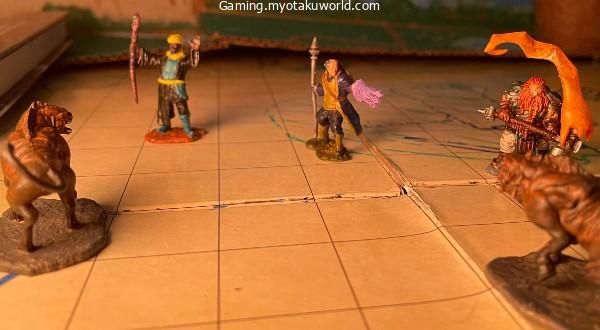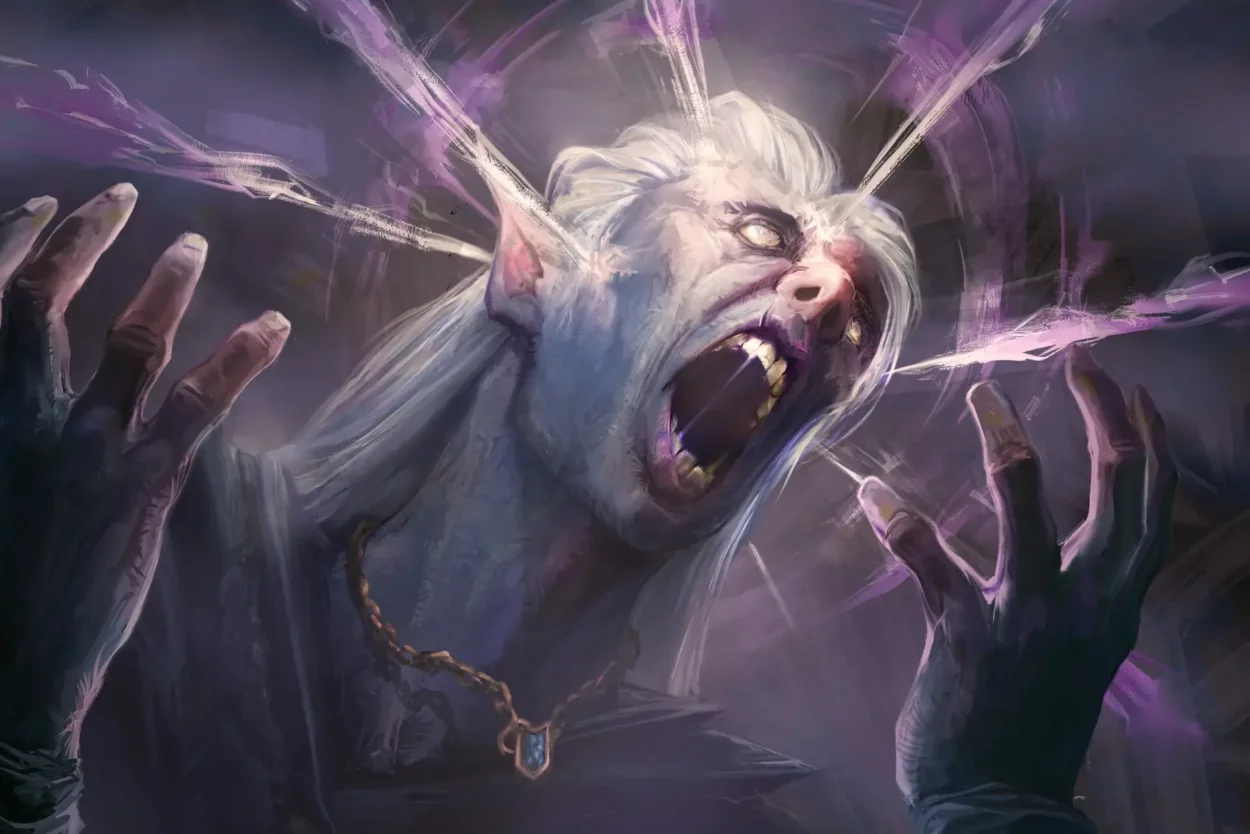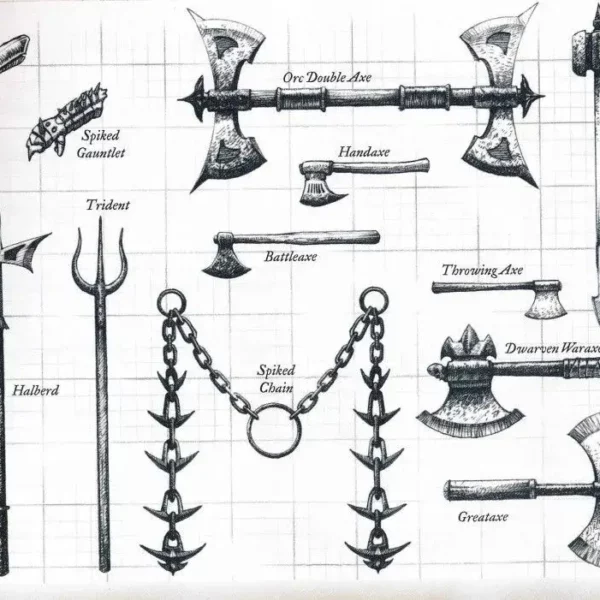Today, we take a deep dive into the twisted depths of our own minds… Or rather, the minds of our foes!
Yes, today we’re going to talk about Mind Spike, a 5e spell that is known for its easy-to-use early-game damage and very useful side effects.
This spell comes from Xanathar’s Guide to Everything, so we’re moving away from the basics today.
In this guide, I’ll talk about everything from the basic question of what Mind Spike is to the pros and cons of the spell, some examples of how to use Mind Spike, and some final thoughts on whether or not you should take the spell.
- Mind Spike 5e Spell Description
- Mind Spike 5e
- Who Can Cast Mind Spike In 5e?
- What Does Mind Spike Do In 5e?
- What Are The Rules For Mind Spike In 5e?
- How to use Mind Spike 5e Spell?
- Mind Spike 5e Spell Advantages and Disadvantages
- When Should You Use the DND Mind Spike Spell?
- How Often Can You Use DND Mind Spike?
- Is Mind Spike 5e A Good Spell?
- Mind Spike 5e Dm Tips
- FAQs
Mind Spike 5e Spell Description
According to Xanathar’s Guide to Everything, the spell is described as follows:
You reach into the mind of one creature you can see within range. The target must make a Wisdom saving throw, taking 3d8 psychic damage on a failed save, or half as much damage on a successful one.
On a failed save, you also always know the target’s location until the spell ends, but only while the two of you are on the same plane of existence. While you have this knowledge, the target can’t become hidden from you, and if it’s invisible, it gains no benefit from that condition against you.
At Higher Levels. When you cast this spell using a spell slot of 3rd level or higher, the damage increases by 1d8 for each slot level above 2nd.
Mind Spike 5e
| DND Mind Spike Categories | DND Mind Spike Stats |
|---|---|
| Level | 2nd level |
| School | Divination |
| Casting Time | 1 Action |
| Range | 60 feet |
| Components | Somatic (hand movements) |
| Duration | Up to 1 hour with concentration |
| Attack/Save | Wisdom |
| Damage (Failed Wisdom Saving Throw) | 3d8 psychic damage |
| Damage (Successful Wisdom Saving Throw) | Half of 3d8 psychic damage |
| Higher Levels (3rd level or higher) | add 1d8 for each spell slot level above 2nd |
| Spell List | Wizard, Warlock, Sorceror |
Who Can Cast Mind Spike In 5e?
Mind Spike is on the spell list of the following classes:
In addition, certain subclasses of these classes may also have access to the Mind Spike spell. For example, the Mind Domain Cleric subclass can also learn and cast the Mind Spike spell.
What Does Mind Spike Do In 5e?
A creature within 60 feet of Mind Spike has to make a Wisdom saving throw. If your save fails, you take 3d8 (13.5 on average) mental damage.
If you make your save, you take half as much damage. If they fail, you always know where they are as long as you and they are on the same plane.
Now that you know:
- You can’t lose sight of your goal.
- The target doesn’t gain anything from being invisible to you.
If you can keep your focus up, these rider effects can last up to an hour.
Mind Spike can also be cast at a higher level, dealing an extra 1d8 damage per spell slot level above 2nd.
What Are The Rules For Mind Spike In 5e?
Mind Spike has the following rules in D&D 5e:
- As soon as you cast Mind Spike, you can’t focus on another spell you’re casting. “You lose concentration on a spell if you cast another spell that requires concentration” (PHB 203). So even if you don’t want to use Mind Spike’s rider effects and just want to deal damage with it, it will still break your focus on another spell if you cast it at all.
- The rider effect of Mind Spike doesn’t let you target animals you can’t get to easily. “In order to target something, you must be able to see a clear path to it,” the rules say (PHB 204). Mind Spike doesn’t change this general rule. Instead, it just stops the thing from hiding from you or using invisibility against you. So the DM always has to tell you where they are, as long as they are on the same plane.
- The rider effect of Mind Spike stays on the target even if they move away from the person who casts it. According to the rules, “once a spell is cast, its effects aren’t limited by its range, unless the spell’s description says otherwise” (PHB 203).
- The results of Mind Spike are probably felt by the target. “Unless a spell has a perceptible effect, a creature might not even know it was the target of a spell,” the rules say. If a spell doesn’t say otherwise, a more subtle affect, like trying to read a creature’s thoughts, usually goes unnoticed.
This goes along with what Jeremy Crawford said in his book Hex: “A target doesn’t know it’s under the effects of a spell until it feels the effects of the spell.” Since a target knows when a spell is on it when it gets psychic damage, it probably also knows when it is being followed. To get around this, a DM might let the Sorcerer’s Subtle Spell metamagic be used. - Mind Spike works with the Expert Divination feature (PHB 116) of the Divination Wizard. Which lets them get back a spell slot they used up when they cast an insight spell of level 2 or higher (PHB 116). The level of the spell slot you get back can only be lower than the level of the spell slot you used to cast the spell.
But you can still upcast Mind Spike to get back higher-level spell slots. We know this because Sage Advice says so. Just keep in mind that the spell slot you get back is always one less than the one you used to cast Mind Spike.
How to use Mind Spike 5e Spell?

When your mind is this sharp, who needs a sword?
Psychic damage isn’t very common, and there aren’t as many monsters that can avoid it as, say, fire, which most creatures can’t stand.
Having a rare type of damage like Mind Spike in your arsenal can be very helpful. You might not use it in every fight or even every encounter, but when you run into monsters that seem to be immune to everything your party throws at them, Mind Spike might be a good choice.
Steal from the enemy
Even though Mind Spike’s main draw may be its damage type (psychic, which isn’t common) or even its raw damage (3d8 isn’t nothing to sneeze at), one of its more niche uses comes from its side effect: lowjacking the enemy.
After successfully casting Mind Spike, the person who casts it always knows exactly where the target is, whether or not the person can see the target. This is incredibly helpful if you’re facing an enemy that is very sneaky or one that can make itself completely invisible.
Again, this might not be something you deal with often, but when you do, it can be a lifesaver!
Follow the bits of bread
Who needs a tracker when you can use Mind Spike to scare a helpless servant back to where it came from…?
Only to then follow that hired sword back to the person who hired it and find out the truth, or follow that skulking insectoid back to its secret hive to burn it down, or carefully follow that kidnapper back to their underground ring of gnome-smugglers.
Mind Spike 5e Spell Advantages and Disadvantages
Mind Spike is a low-level spell, which is one of its best features. This means that people who can cast spells can use it fairly quickly. Together with its strong 3d8 damage, this can really shake things up on the battlefield.
Even though this is a big plus, the full effect and damage only happen if the enemy fails their save. The save is against WIS, which isn’t a very rare stat, so that is something to think about.
The fact that the secondary effect, which is being able to track the creature affected by the spell, depends on the caster’s focus, which is a big deal and makes the spell less useful.
Some people don’t think this is a big deal, but based on the situation, the caster might be in a place where it’s hard to stay focused, like when they’re in the middle of a fight or caught in an ambush.
This problem is made worse by the fact that the tracking is only “foolproof” if the target fails their save. The target can still hide from the spellcaster if they pass their WIS saving throw even though the spellcaster still knows where they are in general.
Mind Spike’s damage also goes down a lot in the middle and late parts of a campaign, which is bad. Upcasting Mind Spike only adds 1d8 damage to its damage roll. It doesn’t make its tracking effect work better or give it any more uses.
On the other hand, being able to track affected targets is an effect that is useful in every single operation.
The last good thing about Mind Spike is that, other than the initial shock, the target won’t really notice anything about the spell.
If your target doesn’t know your class or have a better sense of magical energy, they won’t even know you’re following them. Even though Mind Spike’s secondary effect isn’t always totally hidden, it is always sneaky.
Mind Spike has a lot of good things about it, but it also has a lot of bad things that a player needs to think about before taking it. Its pros and cons are pretty similar, but it’s up to each person to decide which ones are more or less important.
When Should You Use the DND Mind Spike Spell?
When your enemy is hiding, unseen, or might become invisible is the most important time to use Mind Spike.
It’s also a great spell to use against other spellcasters because it will break their focus, hurt them, and tell you where they are.
If your opponent is always trying to hide or become invisible, Mind Spike can be a great way to beat them.
Even if they do get away, you can still find them during battle.
If your magical character is silent, you should also use Mind Spike. The spell doesn’t need anything to be said out loud; only motions are needed. Even if your spellcaster can’t cast magic, you can still hurt your enemy in other ways.
Lastly, you should only use this spell if the person you want to affect is within 60 feet.
You shouldn’t waste a power slot.
How Often Can You Use DND Mind Spike?
Mind Spike can be used as many times as your spell slots for second-level spells.
For example, you can cast Mind Spike three times if you have three second-level magic slots.
If you get more spell options, you can also use the spell again.
Most of the time, you need at least 8 hours of rest to get new skill slots. You can meditate for 4 hours if your character is an elf.
Each time you cast the spell, the impact lasts for up to one hour of game time.
That means you don’t have to cast the spell again on the same subject within an hour, as long as you keep focusing on it.
If you want to cast the spell again after an hour or if you lose focus, you will need to use a different spell spot.
Is Mind Spike 5e A Good Spell?
No, the Mind Spike spell is not good. Because it needs focus, you can’t really use it as a blasting spell in combat once you’ve set up your more powerful spells to control the battlefield (Hypnotic Pattern, Hold Person, Web, etc.).
It’s almost a trap for Divination Wizards who think that the “regain spell slot” feature is a magic bullet like a Coffee Lock build. It’s not a good idea to use Mind Spike just to get back a lower-leveled spell spot.
Still, from a damage standpoint, Mind Spike is right up there with spells like Shatter. Plus, if you make a good save, you take half as much damage, and mental damage is a nice bonus.
Mind Spike is the best spell to use if you really need to find an enemy or keep an eye on an unseen creature during a fight.
But besides these narrow uses, you’re probably better off using your move on something else.
Mind Spike 5e Dm Tips
Players sometimes ask DMs if the metamagic Subtle Spell can make it so Mind Spike doesn’t get noticed.
Even though the target won’t know who cast the spell, I think that 3d8 psychic damage is obvious and sudden enough for anyone in the DnD world to suspect magic.
So, if a person wants to use Mind Spike to pull off a trick like this, I say let them.
For instance, they might want to keep an eye on a royal guard who goes to group meetings. As soon as the Sorcerer of the party steps out into the sun, he uses Subtle Spell to cast Mind Spike.
Maybe he thinks the sudden damage to his mind is just a headache from the sudden light and goes on with his day.
Since Mind Spike doesn’t come up very often, I’m likely to let this one go because it’s fun and different from the usual ways to track someone.
FAQs
Can you cast Mind Spike with other spells?
It depends. You can cast it for the damage it does, but the fact that it also tells you where the target is takes concentration. You can only concentrate on one spell at a time, and any damage or situation that might break your focus forces you to roll a CON save with a DC equal to either 10 or half the damage you’re taking.
Is Mind Spike 5e a good spell to use in a fight?
For the harm it did? Of course. For the bad things it does? Perhaps. As it’s a spell that requires concentration, keeping it up in the middle of a fight could be hard if you’re taking damage from the enemy or need to cast another spell that also requires concentration.
Does Mind Spike 5e have any drawbacks?
It takes concentration, which means that keeping it up in the middle of a fight might be hard. Another problem is that it needs a somatic component. This means that a user who is tied down or whose hands are being used for something else would not be able to use it.
Does Mind Spike 5e work on creatures with mind-affecting immunities?
As a general rule, since it isn’t directly controlling the creature’s mind, it should be able to affect animals that are immune to mind-affecting effects, since that immunity is mostly about being forced and less about being watched. It’s best to ask your DM because their idea of what “mind-affecting” means might be wider or more inclusive.









